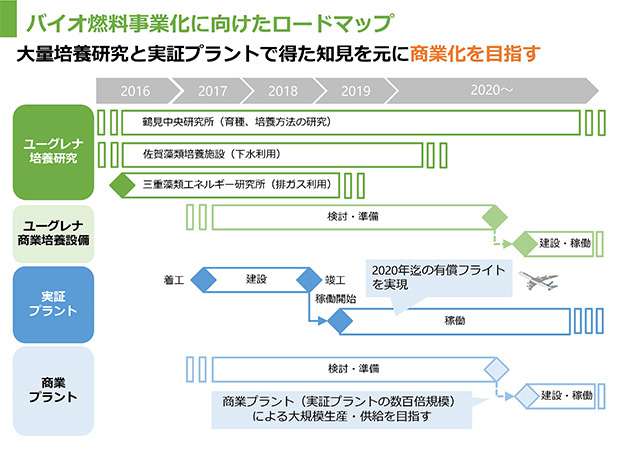euglena Project
06
Japan's first bio jet
Fuel manufacturing plant
Build it.
Start of domestic biofuel plan
2014.07
Ongoing
Toward a technical alliance with the world's largest oil company, Chevron Group
In the summer of 2014, Akihiko Nagata, then director of business strategy, was in California, USA. Opposite Nagata is the key person in the joint venture of Chevron, the world's largest oil company.
At that time, Nagata faced a major challenge in advancing the biofuel business in Japan. I flew to America to solve it.

ユーグレナ社は、2012年の東証マザーズ上場時より、宣言し続けていることがある。「2020年までにユーグレナなどの微細藻類から作った燃料で飛行機を飛ばす」ことだ。
水素や電気などの代替エネルギーの活用が難しい飛行機や大型自動車(バスやトラック)において、石油由来の燃料に変わるバイオ燃料の実現は、地球環境の観点からも、資源の乏しい日本という国の観点からも強く求められている。
この未来を実現するためには、ユーグレナなどの微細藻類から原油を作るだけではなく、原油から燃料を作り出すバイオ燃料専用の製造プラントが必要である。石油を製油所でガソリンやジェット燃料にすることと同じ仕組みだ。しかし日本にはバイオジェット燃料を製造するために必要なASTM規格*1適合のバイオ燃料製造プラントがなく、またASTM規格に適合する製造プラントを設計するための燃料製造技術も、2014年の日本にはなかった。
* 1: ASTM standard: A standard established by the American Society for Testing and Materials, which is the world's largest standardization body. Jet fuels used in aircraft worldwide are required to comply with ASTM standards.
「このままでは原料をどれだけ開発しても、バイオジェット燃料製造の実現は果たせない…」
永田はなんとしてもバイオジェット燃料事業を成立させるために、新日本石油出身でバイオ燃料や石油業界に詳しい当社技術顧問の太田と協議・調査を重ね、ユーグレナの油脂と相性がよいと考えられるバイオジェット・ディーゼル燃料等の製造技術を見出した。そして、その技術を持つシェブロンとの関係構築のため、アメリカの西海岸に向かったのだった。
However, our annual sales at that time were about 3 billion yen. It is a risky challenge for a venture company that has been in business for less than 10 years to build a fuel manufacturing plant that requires a huge amount of money. What's more, the Biofuels ISO Conversion technology required for biojet fuel production has never been licensed outside of US companies in the past. Moreover, we are not a fuel manufacturer. Is it possible for the world's largest oil company to license to a venture company with limited financial resources on an equal footing?

Nagata at the time of 2014 was always thinking about what to do to make the biofuel business successful.
As a result of the negotiations, in May 2015, Nagata and Chevron Lummus Global LLC, a joint venture funded by Chevron, granted the technology license required to manufacture biofuels and engineered the basic design of equipment * 2. Realize the conclusion of the contract. Looking back on that time, Nagata says.
"We had various discussions with many people and received their support, but at the very end, we were young, and we wanted to respond to our desire to change the world ... Naniwabushi. This experience abroad was It must be great in future management. "
* 2: Since the technology for manufacturing jet diesel fuel, etc. from various biomass fats and oils disclosed by Chevron was compliant with the specifications and regulations for the US location, it is necessary to revise to Japanese regulations and JIS standards. It was necessary to recreate the basic design of.
"Domestic biofuel plan" to start moving
Even in Japan, there were a lot of problems that had to be solved for realization. One of them is land search. Since the production of biofuel is dangerous goods, the place where the plant can be constructed is limited, and it must be close to the airport where the biofuel will actually be refueled.
Who will design and operate the next one when it comes to construction in Japan? And who will carry it to the airport? Who will use it at the end ... Finding a partner company to realize bio-jet fuel flights in Japan was also a major issue.
Depending on the conditions, the plant can be constructed in an industrial area and an area close to the airport. It was difficult to find a candidate site that met the conditions, so I searched around while calling out to all local governments from Hokkaido in the east to Okinawa in the west. With the introduction of Yokohama City, we were able to decide on a vacant lot in the Asahi Glass Keihin Plant as the construction site. As other cooperating companies, ANA, Isuzu Motors, and Itochu Enex will jointly build a system for the realization of bio-jet fuel.
Nagata's tenacious negotiations were successful, and we were finally able to start the basic design for the demonstration plant in Japan.
And December 2015. With the cooperation of Yokohama City, Chiyoda Corporation, Itochu Enex, Isuzu Motors, and ANA, we announced the start of the "Domestic Biofuel Plan," a plan to put domestic biojets and diesel fuel into practical use toward 2020.
Through a technical tie-up with a Chevron subsidiary, we will build Japan's first biojet diesel fuel production demonstration plant, aiming to realize paid flights with biojet fuel and public road driving with biodiesel fuel with the cooperation of each company. Publicly declared.

Press conference on "Domestic Biofuel Plan" at ANA Hangar
The following year, on June 1, 2017, a groundbreaking ceremony was held for a bio-manufacturing demonstration plant at the planned construction site in the Asahi Glass Keihin Plant.
Two and a half years to reach the target of 2020. The construction period has been confirmed by a contract contract with Chiyoda Corporation, and it is scheduled to be completed in October 2018 and start operation in the first half of 2019.
Nagata continues to carry on Japan's expectations and continue to pursue the commercialization of the biofuel business.
Posted in July 2017
Euglena Data
-About the roadmap for commercialization of biofuels-

Character
- Akihiko Nagata, Executive Vice President
-

I didn't want to create a reason why the bio-jet fuel business couldn't be realized in Japan by saying, "There is no such thing."
We will fulfill our responsibilities with a vision and execution ability that are unique to venture companies. "
euglena Projects
vol.00
Bangladeshi children
Find the material to save.
vol.01
Euglena that no one has achieved
Establish outdoor mass culture technology.
vol.02
Euglena
Grow it into a 30 billion yen market.
vol.03
Bangladesh
Lunch for all elementary schools.
vol.04
With CO2 emitted from the chimney
Cultivate Euglena.
vol.05
Euglena cosmetics business
Get up.
vol.06
Japan's first bio-jet fuel
Build a manufacturing plant.
vol.07
The name of "Euglena"
Use it as a weapon.
vol.08
Bringing Euglena to China
Spread it.
vol.09
Acquire super-Euglena.
vol.10
Solve the poverty issue in Bangladesh with the Mung Bean Project.
vol.11
Euglena with Takeda
Develop new products.
vol.12
Utilizing sewage from sewage treatment plants,
Cultivate Euglena.
vol.13
Create a set of guiding principles for euglena’s employees.
vol.14
Japan's unique technology
Cultivate Euglena.
vol.15
Aim to create an office that promotes a pleasant working environment for our employees.
vol.16
Establish the Yugurin Nursery School next to our office.
vol.17
Euglena in Ishigaki Island
Contribute to regional revitalization.
vol.18
Raise awareness of Euglena
Jointly develop new products
vol.19
Euglena cafe
Open a store on Ishigaki Island.
vol.20
Using Euglena as fodder
Raise Hinai chicken.
vol.21
Euglena-containing diesel fuel
Collaborate with Isuzu Motors to put it into practical use.
vol.22
using Euglena
Produce biofuel.
vol.23
研究系ベンチャーを
ヒト、モノ、カネで支える
新しいファンドを確立せよ。
© 2018 MELTIN MMI
vol.24
The world's first Euglena and chlorella
Get ASC-MSC algae certification.
vol.25
Build synergy with group companies.
vol.26
With new friends
Make people healthy at the genetic level.
vol.27
Jiyugaoka and
Popularize Euglena.
vol.28
Euglena supplement
Start up a processing plant.
vol.29
Contribute to community revitalization on Ishigaki Island through the power of science.
vol.30
new Euglena
Develop core cosmetics.
vol.31
Contribute toward solving food shortages among Rohingya refugees.
vol.32
Beauty ingredients derived from Euglena
Unravel your research.
vol.33
Supporting students in taking on challenges!
Start all-year-round recruitment.
vol.34
Euglena and Chlorella
Get halal certification.
vol.35
Euglena that extends healthy life expectancy
Discover possibilities.
vol.36
Taketomi Island prawn farming business
Develop.
vol.37
Drive your car on Euglena biodiesel fuel at the G20 Karuizawa.
vol.38
Plan a mascot character to communicate the appeal of Euglena from Ishigaki Island.
vol.39
Recruit and select CFOs (Chief Financial Officers).
vol.40
Domestic Kalahari watermelon
Cultivate.
vol.41
Japan's first "virtual only
Hold a general meeting of shareholders.
vol.42
next-generation biodiesel fuel
popularize it
vol.43
Corporate
Renew your identity.
vol.44
Born in Ishigaki Island
Euglena permeate.
vol.45
derived from Euglena
Accelerate fertilizer research.
vol.46
Japan's skies with biofuel
keep it clean.
vol.47
improve the office environment
Make your teammates more productive.
vol.48
in cosmetics
Pursue sustainability
vol.49
Next new material "Midori Koji"
Spread your value to the world.
vol.50
ユーグレナの
ESG経営を加速させよ
vol.51
未来世代アドバイザリーボードを
設置せよ。
